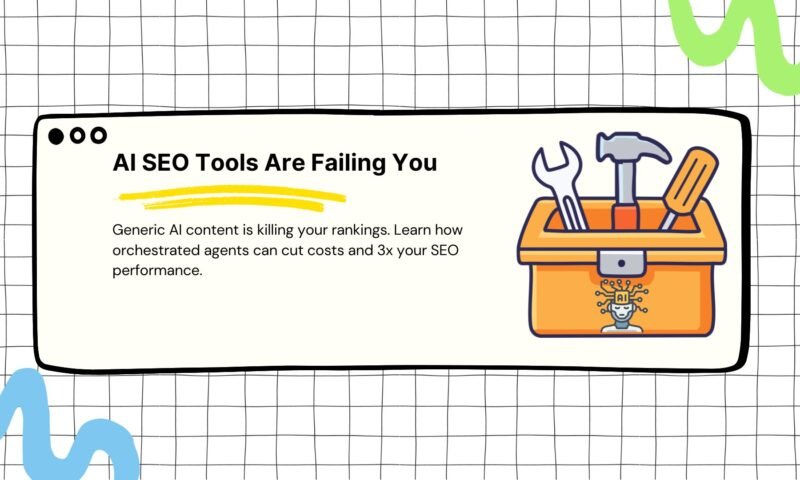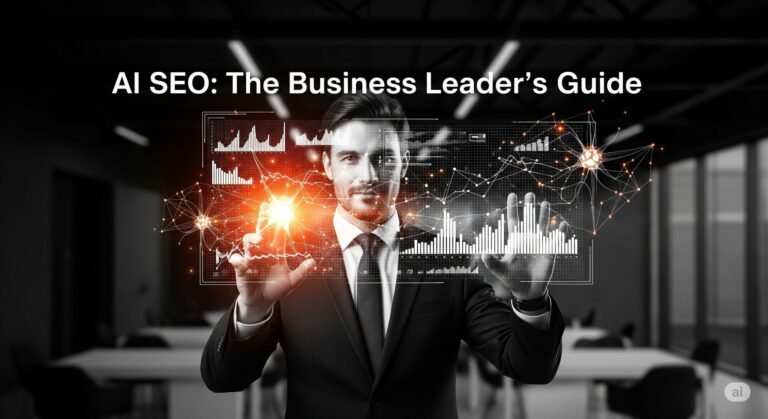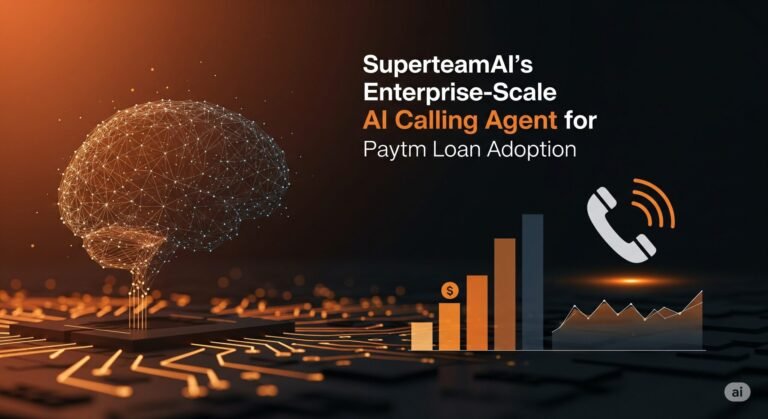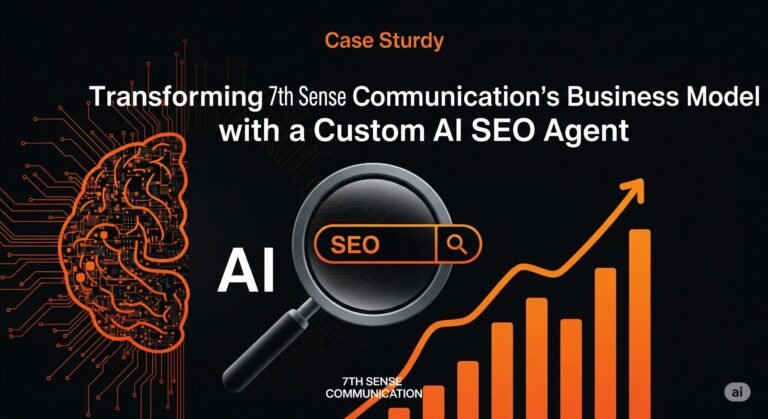
By Arup Chatterjee, Founder of SuperteamAI
Imagine pouring hours into AI-generated content, only to watch it sink in search results. No traffic, no leads—just a mountain of wasted effort and expense. That’s the trap I fell into. As a growth hacker scaling my first ventures, I lost millions in operational quicksand, much of it from generic SEO articles that never ranked.
My teams of 5-10 people would spend 4-6 hours daily just tweaking drafts from basic AI tools. We were stacking SaaS costs without seeing results. It was a frustrating, expensive cycle that stalled our growth.
But that experience led to a breakthrough. By shifting from standalone tools to a system of orchestrated SEO AI agents with smart human oversight, we turned everything around. Today, my business operates at 77% lower costs than our previous expenses, executes SEO strategies 300% faster, and achieves 95% accuracy on content tasks.
If you’re a 5-50 employee agency or SaaS firm battling the same slow rankings and high costs, this guide will show you how to escape the standalone AI trap and build a winning SEO strategy for the new age of search.
Part 1: The Silent Killer in Your SEO Strategy: The Failure of Standalone AI Tools
The initial promise of AI for SEO was intoxicating: instant content, effortless optimization, and scalable growth. The reality, for most scaling businesses, has been a rude awakening.
You’re likely experiencing a flood of mediocre content that looks optimized on the surface but ultimately fails to connect with audiences or search engines. Why does this happen?
Because standalone AI tools are task-rabbits, not strategists.
They operate in a vacuum, lacking the context, nuance, and strategic insight required to create content that actually wins. They excel at executing a single command, like “write a blog post about X,” but they fail at the comprehensive process that SEO success demands.
This failure manifests in several critical ways that create bottlenecks and burn resources for growing businesses.
The Generic Content Trap: A Race to the Bottom
The biggest flaw of basic AI writers is that they are fundamentally derivative. They are trained on the existing internet, so their primary function is to find, synthesize, and rephrase what’s already out there. This leads to a sea of homogenous content that lacks originality and fails to provide unique value.
In the eyes of Google’s E-E-A-T (Experience, Expertise, Authoritativeness, Trustworthiness) guidelines, this is a death sentence. To rank today, content must demonstrate first-hand experience and expert insight.
A generic AI tool cannot invent a novel perspective or share a personal case study. It can only rehash the top 10 search results, ensuring your content is, at best, a slightly different version of what your competitors have already published.
Real-World Example: Early on, my team used a popular AI writer to create an article on “SaaS pricing models.” The tool produced a perfectly readable, well-structured article that listed the common models.
The problem? It was identical in substance to every other article on the topic. A competitor, who wrote a similar article but included a detailed case study of how they chose their own pricing model (demonstrating real experience), outranked us within weeks. Our AI-generated piece never broke the third page.
Get Your Free AI SEO Agent
Transform your website’s performance with our powerful SEO AI agents. Complete setup guide included – no technical expertise required.
The Accuracy Gap: How AI Hallucinations Erode Brand Trust
AI models are notorious for “hallucinating”—inventing facts, statistics, and sources with complete confidence. For a business trying to build authority, a single, glaring factual error can be devastating to its credibility. When a reader spots a fake statistic or a misattributed quote, their trust in your brand evaporates.
Fixing these errors requires meticulous human fact-checking, which completely negates the time-saving promise of using AI in the first place. Your team ends up spending more time verifying and correcting the AI’s output than if they had researched the topic from scratch.
Real-World Example: We once published an AI-generated article that cited a “2022 study from Stanford University on marketing automation trends”. A reader commented on the post, asking for a link to the study. After a frantic search, our team discovered the study didn’t exist. The AI had invented it. We had to issue a correction, and our brand’s credibility took a direct hit.
The Readability Fail: Content for Robots, Not Humans
Standalone AI tools often struggle with tone, flow, and rhythm. They can produce grammatically correct but soulless, robotic text. The output is often dense, filled with repetitive sentence structures, and lacks the conversational style that keeps a human reader engaged.
The result is a “wall of text” that repels visitors. Users click, scan the impenetrable block of content, and immediately hit the back button. This sends negative user engagement signals to Google (like high bounce rates and low time-on-page), which in turn hurts your rankings.
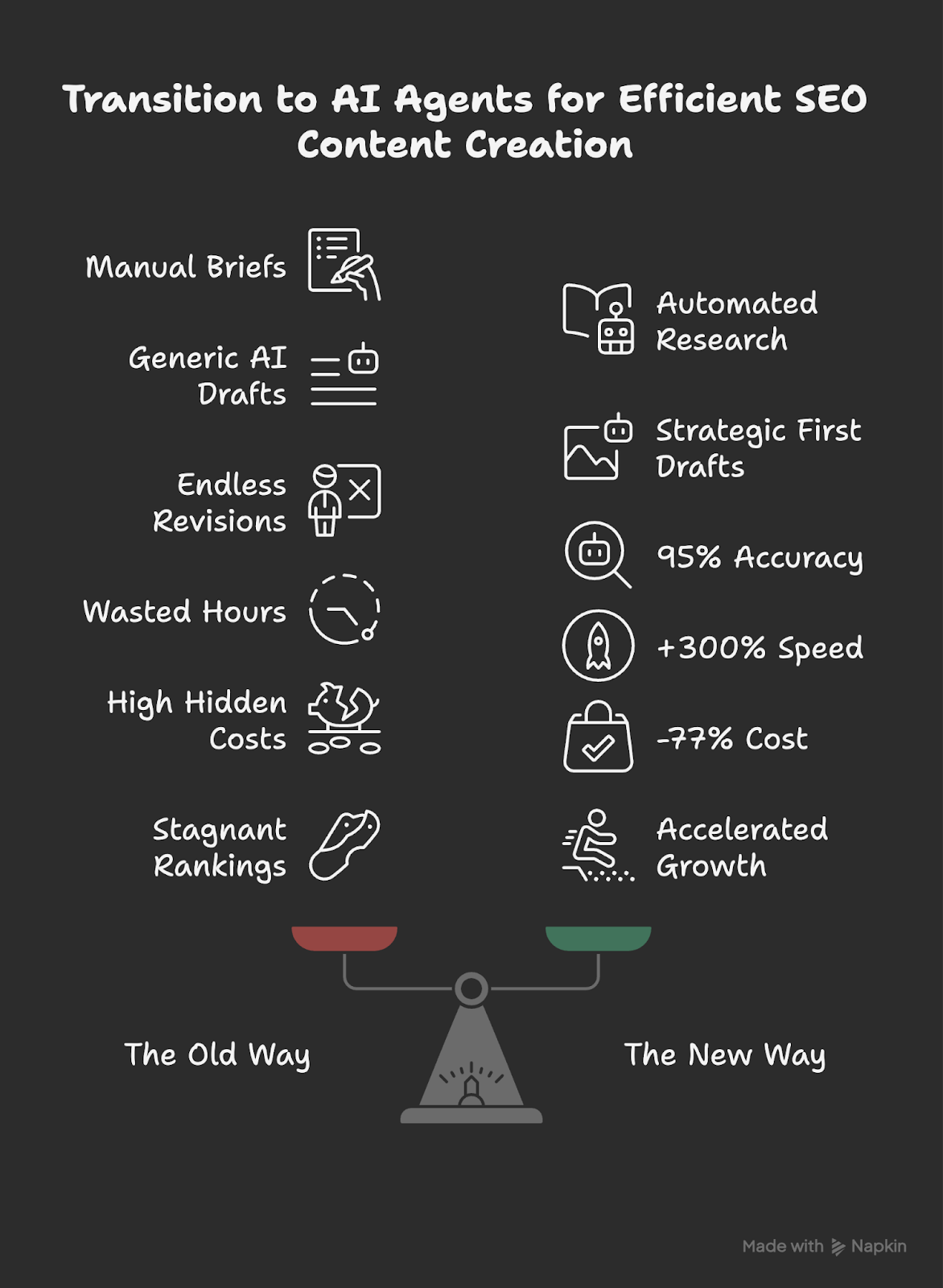
The Hidden Financial Drain: The True Cost of “Cheap” AI
The subscription fee for a standalone AI tool is just the tip of the iceberg. The real cost lies in the wasted human capital.
Let’s do some simple math. Say you have two junior content marketers, each earning $50,000 a year (approx. $25/hour).
If they each spend just two hours per day fixing, fact-checking, and optimizing poor AI drafts, the cost is:
- 4 hours/day * $25/hour = $100 per day
- $100/day * 20 workdays/month = $2,000 per month
- $24,000 per year
That’s $24,000 of your payroll being spent on low-value, remedial work—not on strategy, creativity, or growth. This is the hidden cost that stifles scaling businesses.
Get Your Free AI SEO Agent
Transform your website’s performance with our powerful SEO AI agents. Complete setup guide included – no technical expertise required.
Part 2: The Paradigm Shift: From Isolated Tools to an Intelligent, Orchestrated System
The solution isn’t to abandon AI. That would be like abandoning the internet because of spam. The solution is to evolve your approach from using isolated, dumb tools to deploying a smart, interconnected system.
Think of it this way: A standalone AI tool is like giving a construction worker a single power drill. They can perform one task very quickly, but you still need an architect, a surveyor, a project manager, and an inspector to actually build the house.
An orchestrated SEO AI Agent system is the entire, expert construction crew. It’s a coordinated, digital workforce where specialized agents collaborate on a project from blueprint to final polish, all supervised by an expert human strategist.
How an SEO AI Agent Workforce Functions
Instead of one tool that just writes, an AI Agent system breaks down the complex process of content creation into specialized roles, mimicking a high-functioning human team:
- The Research Agent: This agent acts as your market analyst. It scans the SERPs for a target keyword, analyzes the top-ranking content, identifies content gaps, pulls “People Also Ask” questions, and extracts key entities and topics that Google associates with the query.
- The Strategist Agent: Using the data from the Research Agent, this agent acts as your content strategist. It crafts a comprehensive, data-driven content brief, outlining the target word count, H2/H3 structure, key questions to answer, internal linking opportunities, and the core angle needed to outrank competitors.
- The Writer Agent: This agent takes the detailed brief and generates a high-quality first draft. Because it’s working from a strategic blueprint—not a simple prompt—the output is structured, relevant, and far more nuanced than a generic writer tool.
- The Optimization Agent: Once the draft is written, this agent acts as your on-page SEO expert. It checks for keyword density, ensures target keywords are in titles and headings, formats the text for readability (short paragraphs, bolding, lists), and suggests relevant schema markup.
- The Quality Assurance Agent: This agent cross-references claims and data points against trusted sources to flag potential hallucinations, ensuring factual accuracy before a human even sees the draft.
This integrated workflow eliminates the chaos and inefficiency of the old model. The handoffs are seamless, and the final product is 95% complete before it ever lands on your desk.

Part 3: Mastering the New Search Landscape with an Agent-Based Approach
This integrated system isn’t just about efficiency; it’s a strategic necessity for winning in the new era of AI-driven search. Two concepts are now critical for survival and dominance: AEO and GEO.
AEO (Answer Engine Optimization): Winning the Direct Answer
Google is no longer just a search engine; it’s an answer engine. Features like AI Overviews and Featured Snippets aim to provide direct answers to user queries without requiring a click. To appear in these coveted spots, your content must be structured to provide clear, concise, and authoritative answers.
Standalone tools are terrible at this. They produce long-form prose. An AI agent system, however, is built for AEO. The Research Agent identifies the exact questions users are asking, and the Strategist Agent structures the content brief to answer those questions directly, often in FAQ format or with clear, bolded statements at the beginning of a section. This makes it easy for Google to extract your content as the definitive answer.
GEO (Generative Engine Optimization): Becoming the Source
GEO is the next frontier. It means optimizing your content to be a trusted, citable source for large language models (LLMs) as they synthesize responses for features like Google’s AI Overviews or Perplexity. If your content is generic and derivative, the AI will ignore it.
To win at GEO, your content must be:
- Structurally Sound: Using proper schema markup (like FAQPage, Article, etc.) helps AI engines understand the context of your content.
- Authoritative and Citable: Including unique data, expert quotes, and clear citations signals to AI that your content is a trustworthy source.
- Entity-Rich: Mentioning related people, places, and concepts (entities) helps the AI connect your content to the broader knowledge graph.
An AI agent system is designed to build these elements in from the ground up, ensuring your content is primed to be a foundational source for the next generation of search.
Building Unshakeable Topical Authority with AI Agent Clusters
The ultimate goal of modern SEO is to build topical authority—to be seen by Google as the definitive expert on a particular subject. The most effective way to do this is by creating “topic clusters”: a central “pillar” page covering a broad topic, surrounded by dozens of “cluster” articles that cover specific sub-topics in detail, all linking back to the pillar.
Manually creating a topic cluster is an incredibly resource-intensive process that can take months. This is where AI agents provide an almost unfair advantage.
How it works:
- You define your pillar topic (e.g., “AI for Small Business”).
- The agent system then maps out an entire cluster of 20, 30, or even 50 related sub-topics (“Best AI Accounting Tools,” “How to Use AI for Customer Service,” “ChatGPT Prompts for Marketing,” etc.).
- It then generates strategic briefs and drafts for every single article, complete with a pre-planned internal linking structure.
- This automates months of strategic work, allowing you to build deep authority at an unprecedented scale.

Get Your Free AI SEO Agent
Transform your website’s performance with our powerful SEO AI agents. Complete setup guide included – no technical expertise required.
Part 4: Implementation, Proof, and Your Path Forward
This all sounds powerful in theory, but how do you make it a reality in your organization? It starts with recognizing the most critical component of the entire system.
The Human-in-the-Loop: Your Most Critical Asset
Let’s be crystal clear: this is not about removing humans from the equation. It’s about elevating them. AI is a powerful engine, but a human must be in the driver’s seat. Strategic human oversight is what transforms automated output into brand-aligned, high-ranking assets.
The human’s role shifts from tedious grunt work to high-value strategic direction:
- Setting the Strategy: Defining the core topics, target audience, and business goals.
- Injecting E-E-A-T: Weaving in personal stories, proprietary data, and unique brand insights that AI cannot invent.
- Ensuring Brand Voice: Performing a final review to ensure the content’s tone and style align perfectly with the brand.
- Final Ethical Review: Acting as the final check for accuracy, fairness, and quality.
This human-AI partnership is the secret to producing content that ranks, resonates, and converts.
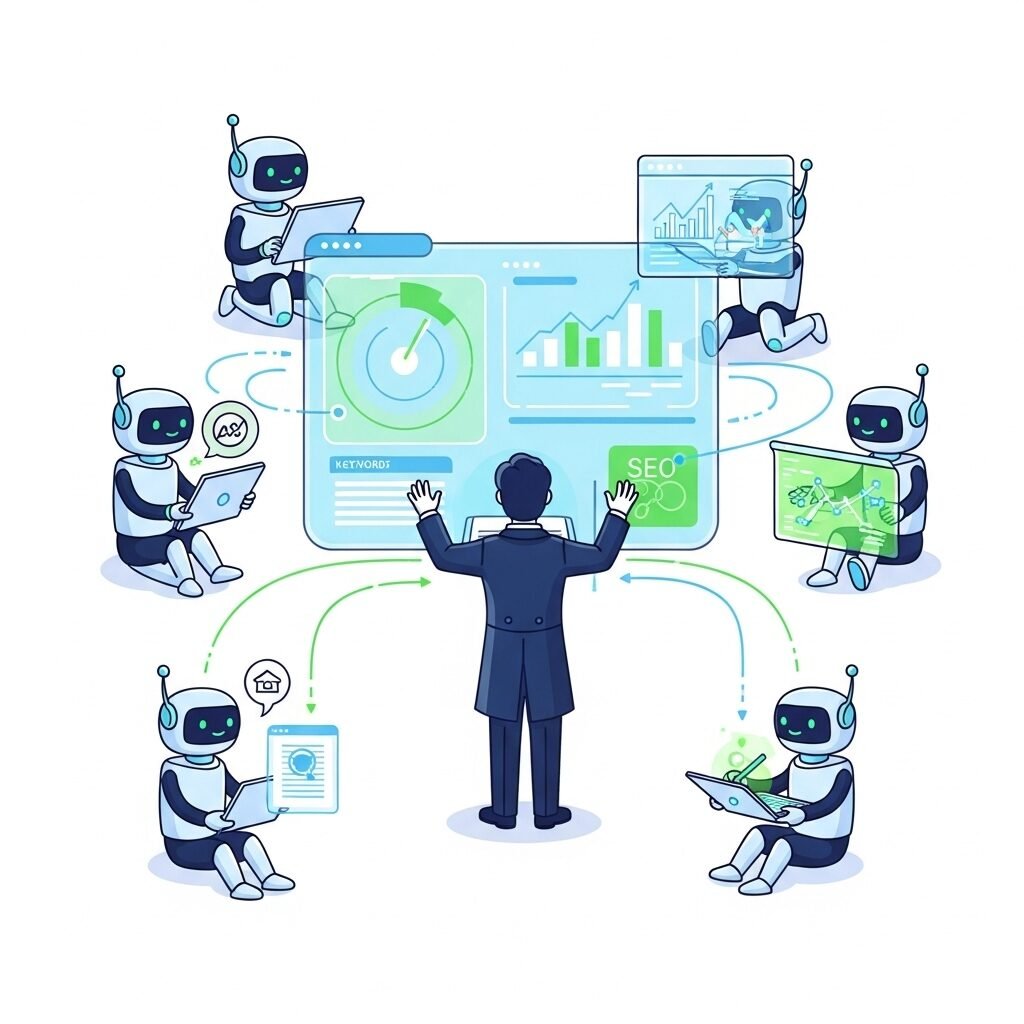
Get Your Free AI SEO Agent
Transform your website’s performance with our powerful SEO AI agents. Complete setup guide included – no technical expertise required.
Measuring the ROI: Key Metrics That Matter to Your CEO
When you shift from standalone tools to an orchestrated agent system, the impact is immediate and measurable. Track these metrics to prove the ROI.
| Metric | Before (Standalone Tools) | After (AI Agent System) | Impact |
| Time to Publish | 2-3 weeks per article | 1-2 days per article | ~300% Faster Execution |
| Cost Per Article | $500 – $1,500 (incl. human hours) | $100 – $200 (incl. oversight) | ~77% Cost Reduction |
| First Draft Accuracy | 40-60% (requires heavy edits) | ~95% (requires minor tweaks) | Massive Efficiency Gain |
| Organic Traffic | Stagnant or slow growth | Aim for 200-300% YoY growth | Measurable Business Growth |
| Bounce Rate | > 60% (unengaging content) | < 50% (high-quality, readable) | Improved User Experience |
Case Study: Transforming a 15-Employee SaaS Firm
We worked with a B2B SaaS company that was stuck in the AI SEO trap. Their 15-person marketing team was burning out, spending most of their time rewriting generic AI content. Their content cost was over $800 per article when factoring in labor, and their publishing cycle was nearly a month long. Organic traffic was completely flat.
The Solution: We helped them implement our AI SEO Workforce. They replaced their chaotic chain of tools with a single, orchestrated system. The Research Agent identified low-competition keywords, the Strategist Agent built briefs, and the Writer Agent produced drafts that were 95% ready.
The Outcomes were transformative:
- Publishing speed skyrocketed by 300%. They went from publishing 2 articles a month to 2 per week.
- Cost per article plummeted to under $150, saving them over $12,000 annually on content creation.
- Most importantly, their deep-dive, high-quality content started to rank. Organic traffic jumped 150% in the first three months, and they began generating high-quality inbound leads directly from their blog.
Your 4-Step Framework to Implement the AI Team Model
Ready to make the change? Follow this simple framework to replace chaotic workflows with a streamlined, effective AI-powered content engine.
- Audit & Calculate Your True Cost: The first step is to face the numbers. Identify your current bottlenecks and calculate your true cost per article, including all the hidden hours of human labour.
- Deploy Your First Agent Workflow: Don’t try to boil the ocean. Start with one, high-effort process. A great starting point is automating the entire workflow from a single keyword to a fully-optimised, ready-to-publish article using a tool like our WP Article Builder.
- Assign a Human Overseer: Designate one person on your team to be the strategic “human-in-the-loop.” Their job is not to rewrite but to provide the final 5% of polish—adding unique insights, checking for brand voice, and giving the final approval.
- Measure, Iterate, and Scale: Track your gains in speed, cost, and accuracy. Use these metrics to build a business case for scaling the model. Once you’ve perfected the single-article workflow, expand to more advanced strategies like automating entire Topical Authority Clusters.
This model seamlessly replaces the inefficient processes that bog down your team, freeing them to focus on the high-level strategy that drives real growth.
Get Your Free AI SEO Agent
Transform your website’s performance with our powerful SEO AI agents. Complete setup guide included – no technical expertise required.
Conclusion: Stop Tinkering, Start Orchestrating
The era of simple AI SEO tools is over. Continuing to rely on them is like trying to win a Formula 1 race with a go-kart. The path to scalable, profitable organic growth lies in a fundamental shift in thinking: from isolated tasks to integrated workflows, from standalone tools to collaborative AI agents.
By embracing an orchestrated, agent-based system with strategic human oversight, you can finally deliver on the original promise of AI—slashing costs, accelerating your execution, and building a content engine that consistently wins in the search results.
